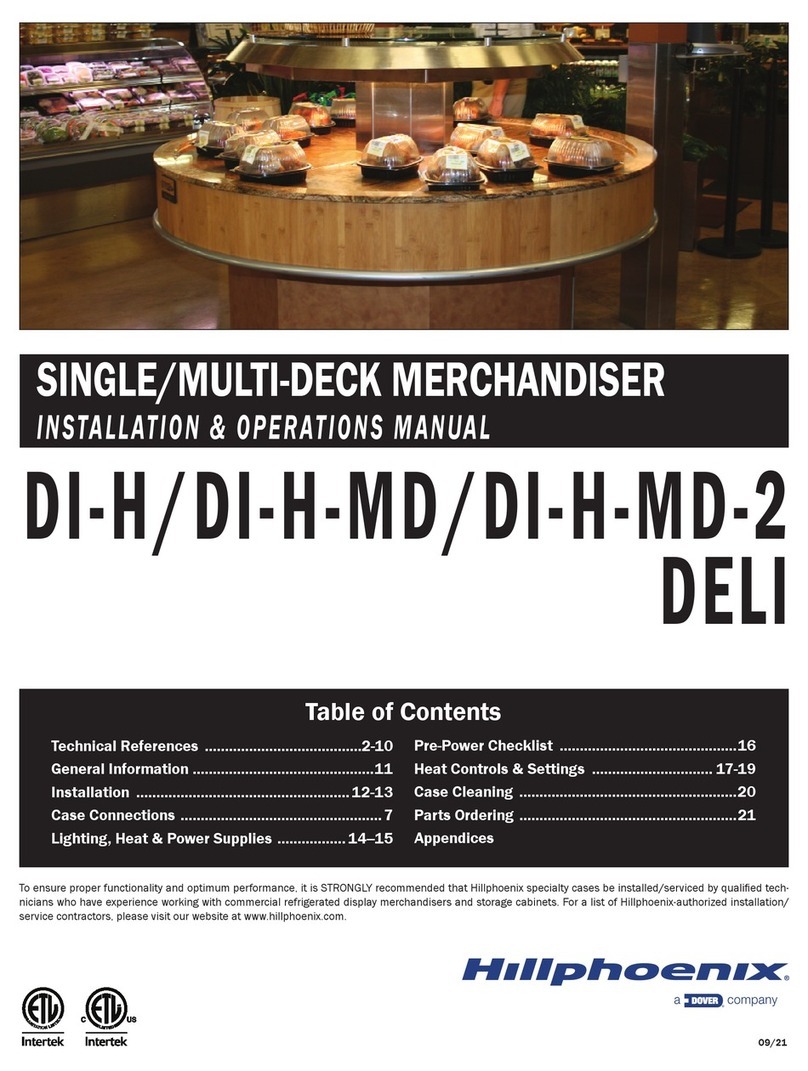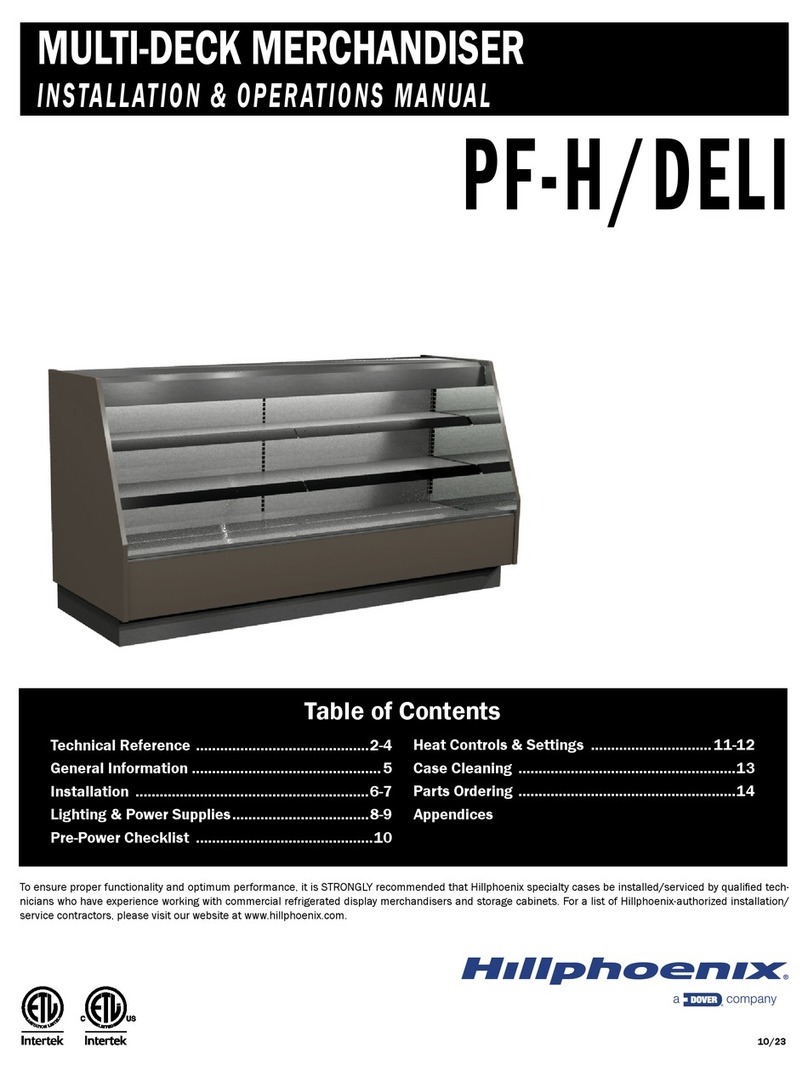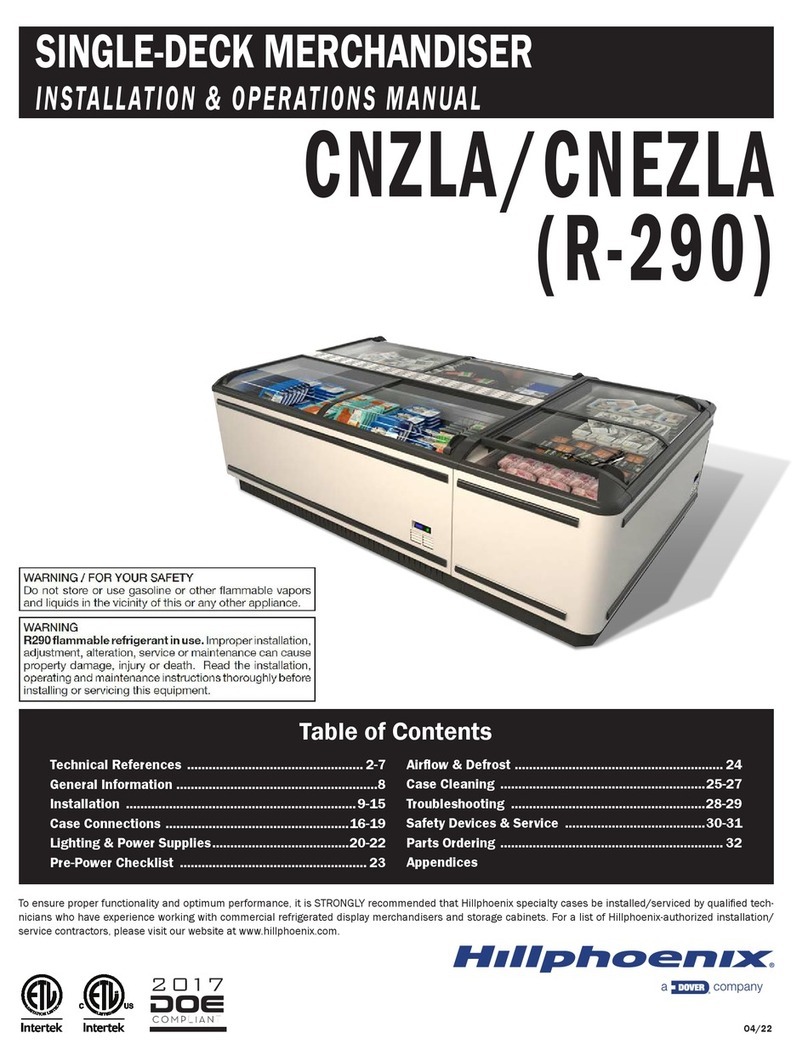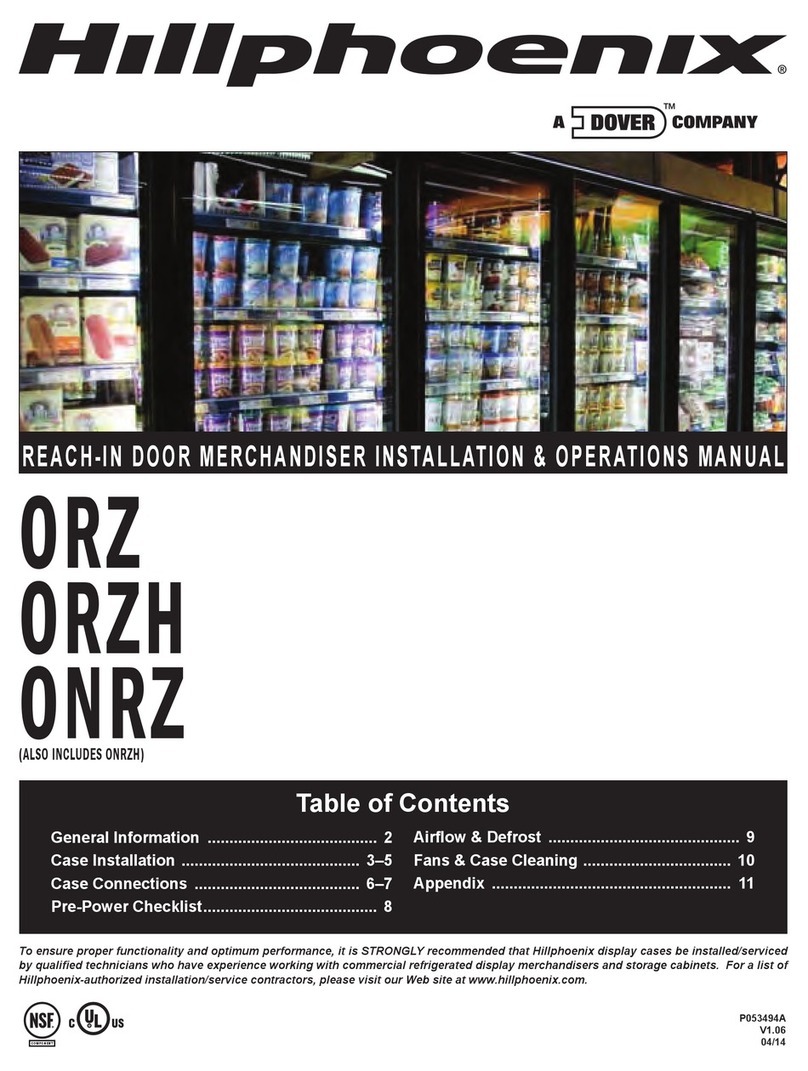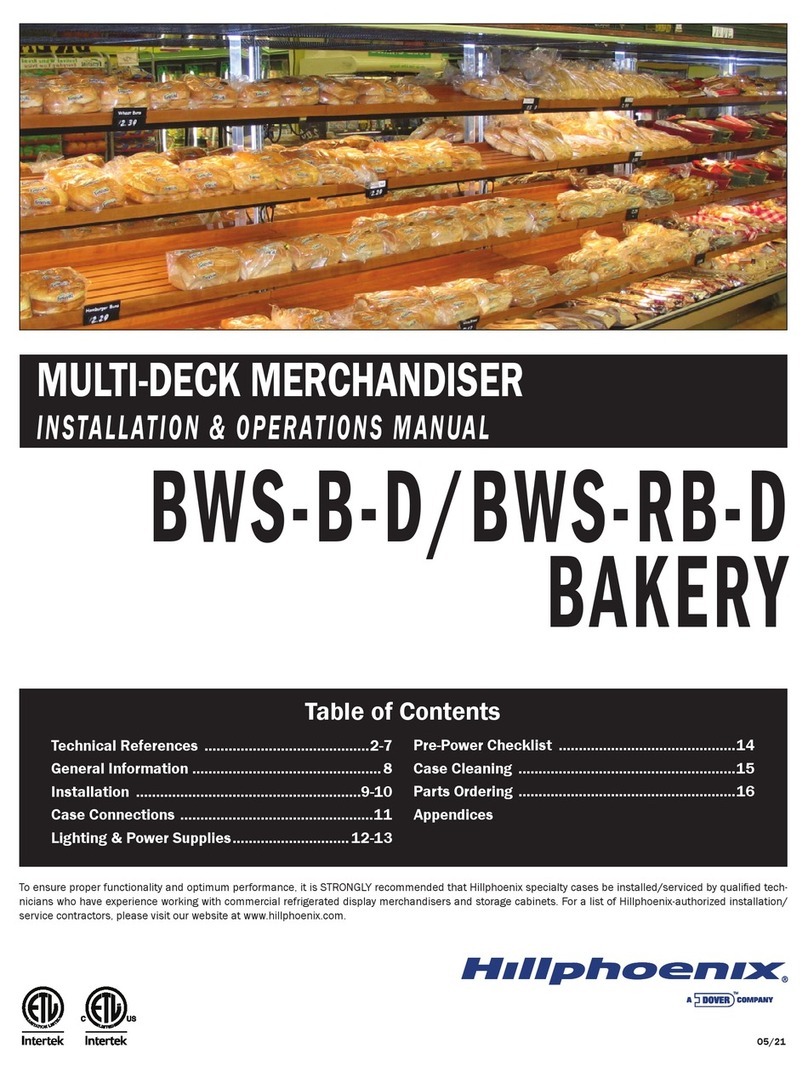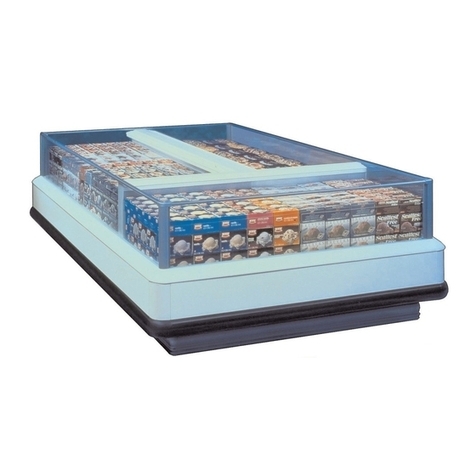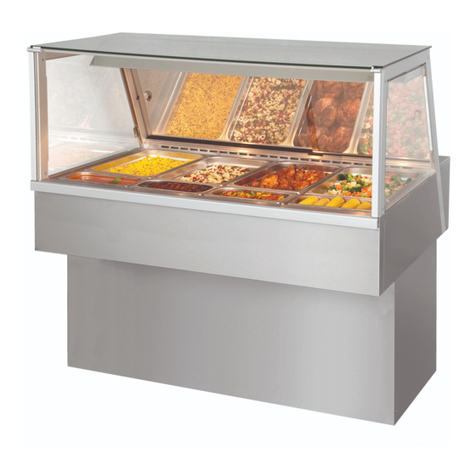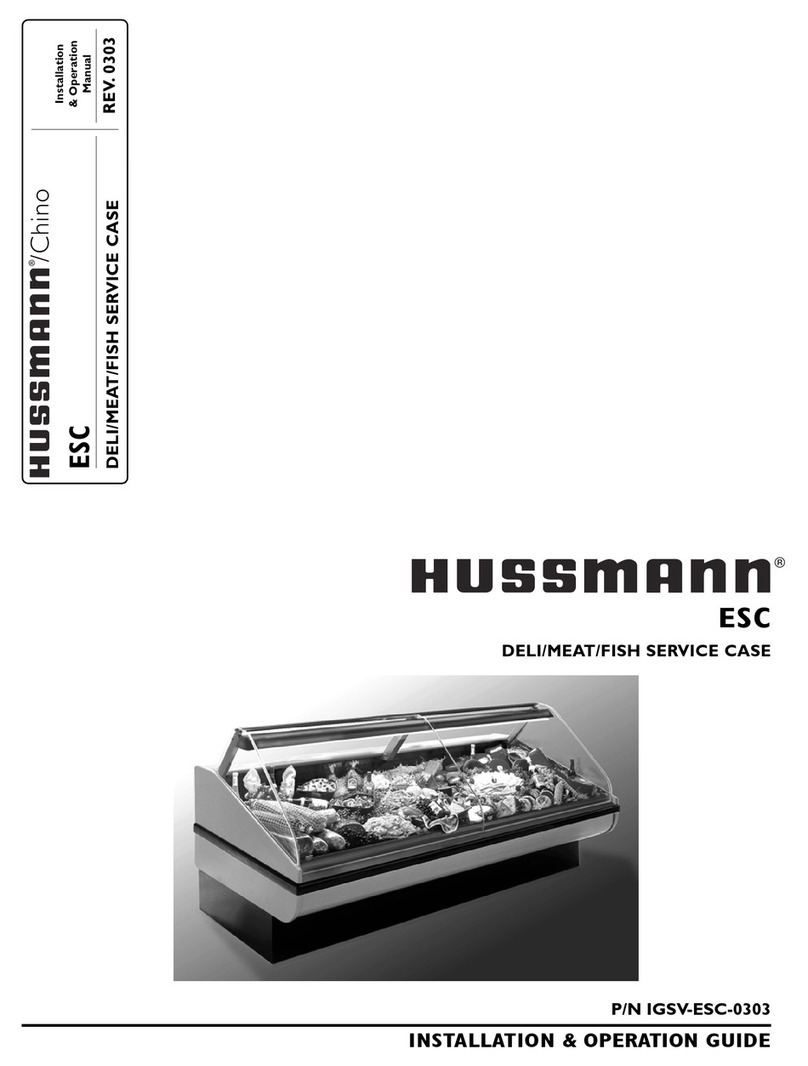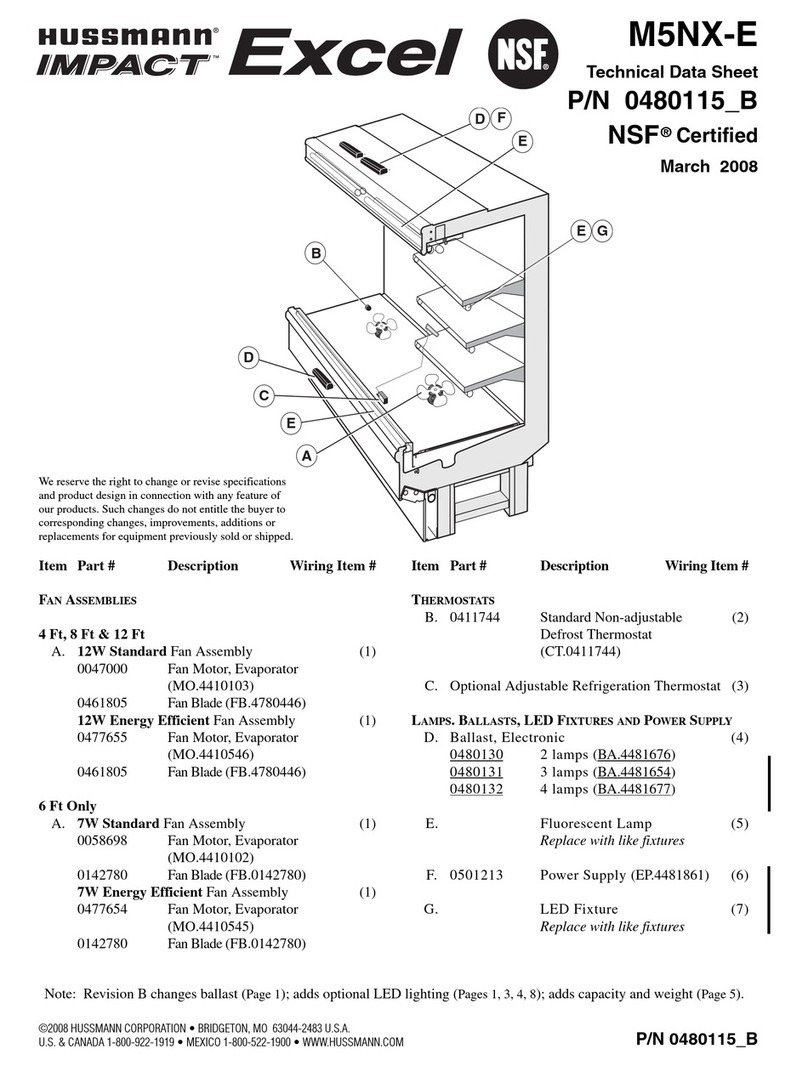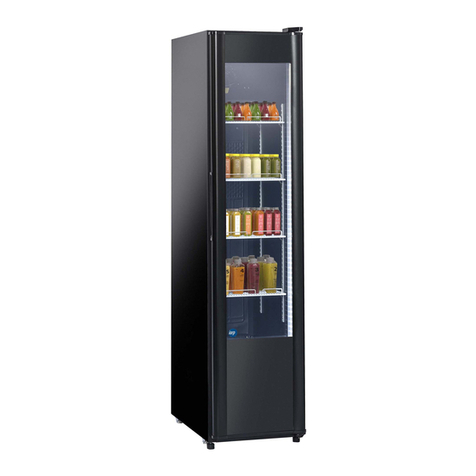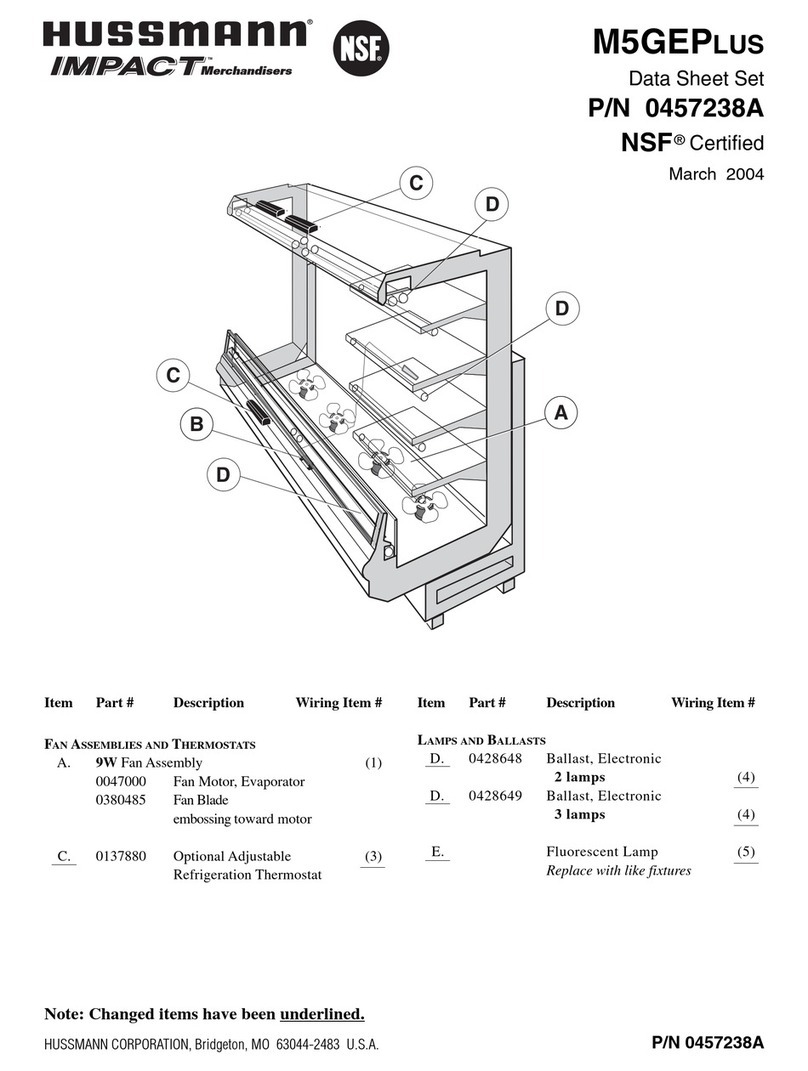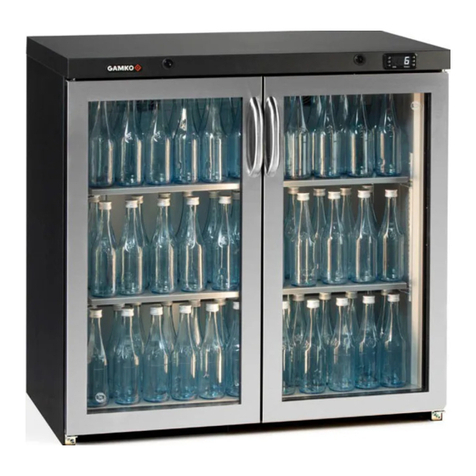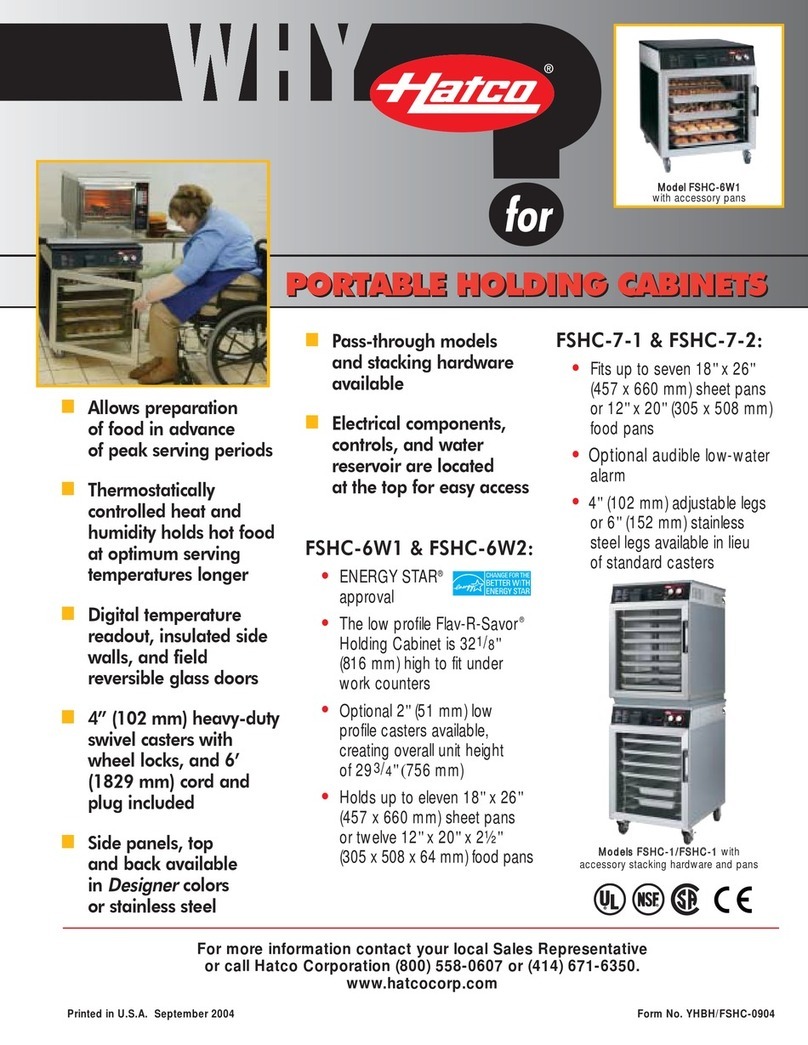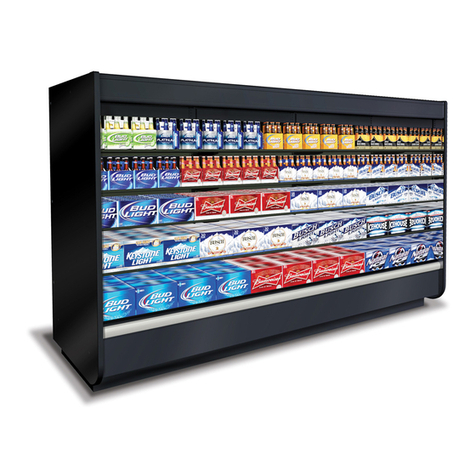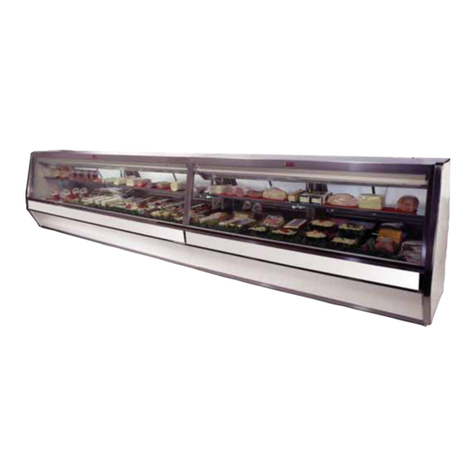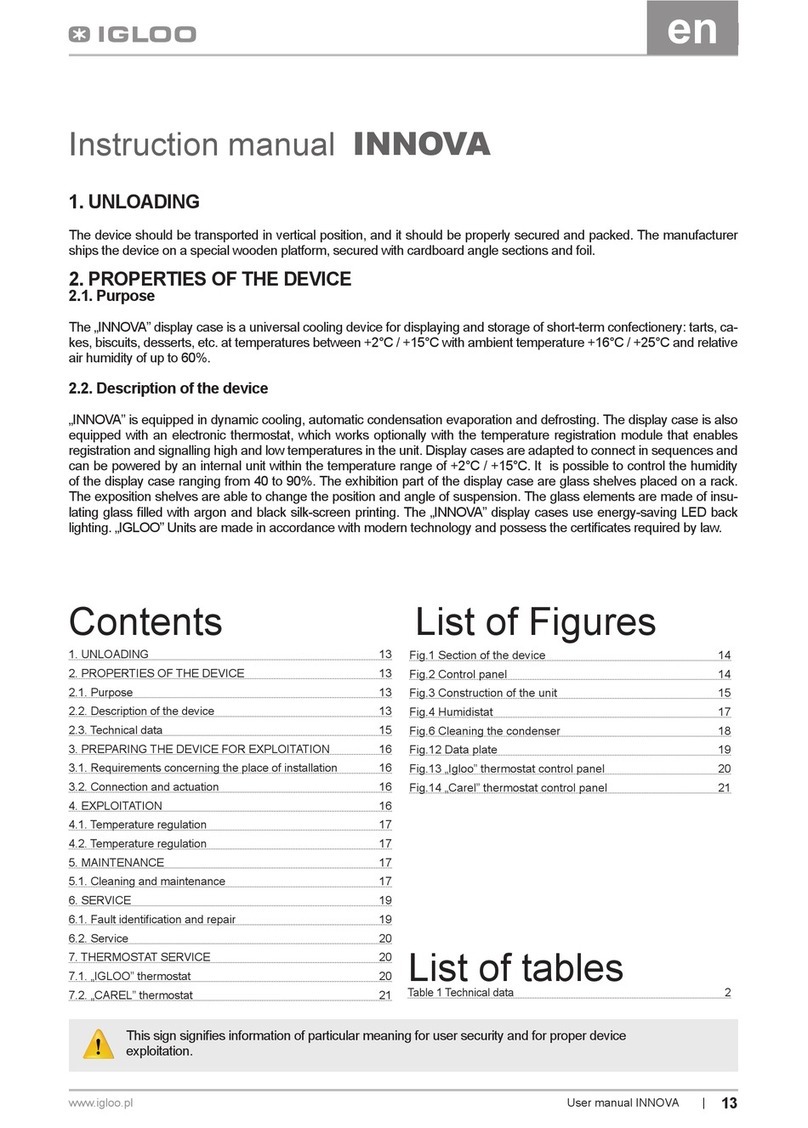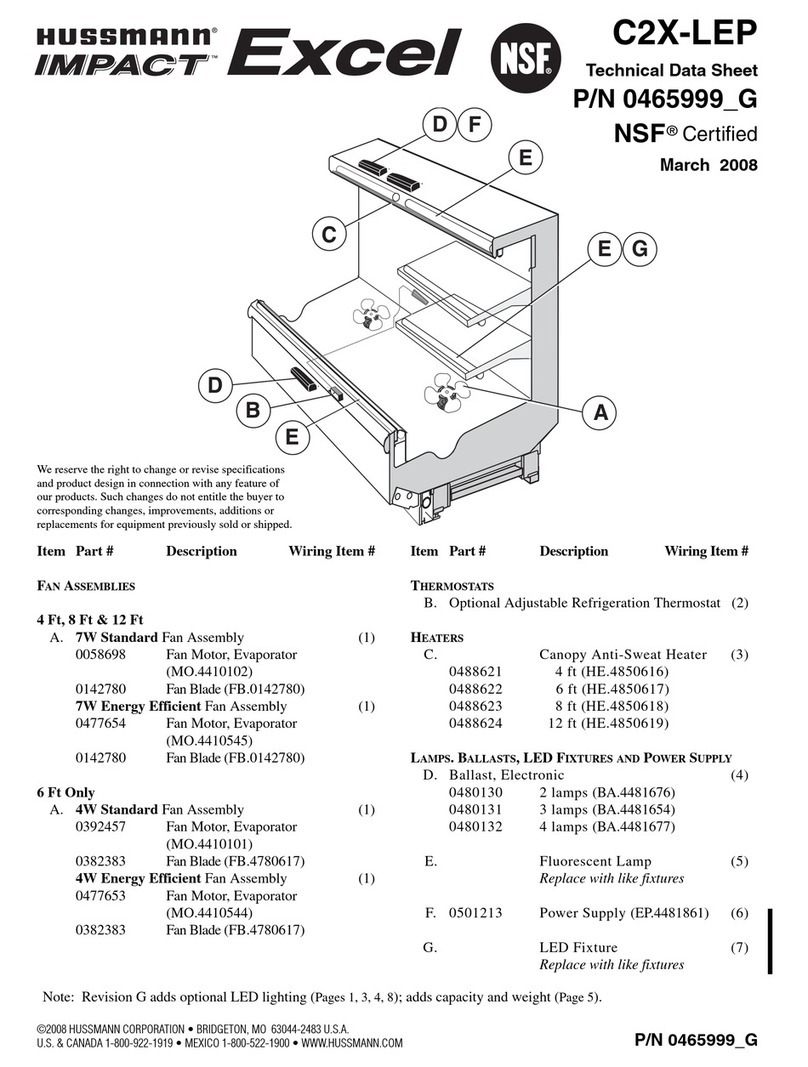Dover ACUULINE JNRBH User manual

JNRBH
REACH-IN DOOR MERCHANDISER
INSTALLATION & OPERATIONS MANUAL
General Information .............................................. 2
Case Installation ................................................ 3-5
Case Connections .............................................. 6-7
Pre-Power Checklist............................................... 8
Airow & Defrost ................................................... 9
Fans & Case Cleaning ......................................... 10
Appendix .............................................................. 11
Table of Contents
To ensure proper functionality and optimum performance, it is strongly recommended that Hillphoenix display cases be installed/serviced by qualied and
certied technicians who have experience working with commercial refrigerated display merchandisers and storage cabinets. For a list of Hillphoenix authorized
installation/service contractors, please visit our Web site: www.hillphoenix.com
COMPONENT
P117627B
Rev 1.0
04/23

Copyright © 2012 by Hill PHOENIX
All rights reserved. No part of this document may reproduced or transmitted in any form or by any means - i.e., electronic
or mechanical, including photocopying, recording or any other information storage and retrieval system - without express
written permission from Hill PHOENIX.

iii
R-744 (CO2) NOTICE
For Systems Utilizing R-744 (CO2) Refrigerant
For refrigeration units that utilize R-744 (CO2), pressure relief
and pressure-regulating relief valves may need to be installed
based on the system capacity. The valves need to be located
such that no stop valve is positioned between the relief valves
and the parts or section of the system being protected.
When de-energizing refrigeration units containing R-744 (CO2),
venting of the R-744 (CO2) refrigerant may occur through the
pressure regulating relief valves. These valves are located on
the refrigeration system and not on the case model. If venting
does occur, the valve must not be defeated, capped, or altered
by any means.
WARNING: UNDER NO CIRCUMSTANCES should any
component be replaced or added without consulting
Hillphoenix Field Service Engineering. Utilizing improper
components may result in serious injury to persons or
damage to the system.
GLYCOL NOTICE
For Systems Utilizing Glycol Refrigerant
Use of glycol as a secondary refrigerant must be carried out in
accordance with the instructions and procedures set forth in
the Hillphoenix Second Nature Medium Temperature Secondary
Refrigeration Installation Manual, available online for download
here: http://goo.gl/JIWd77
Additionally, Hillphoenix uses and recommends Dow glycol-
based coolants, which contain specially formulated industrial
inhibitors that help to prevent corrosion in our display cases.
Over time, the effectiveness of these inhibitors deteriorates,
increasing the chance for corrosion. We recommend testing of
glycol solutions annually through the Dow lab. The service is
free for systems containing over 250 gallons of glycol coolants,
while the cost is approximately $100 for smaller systems. For
more information, see Dow’s DOWFROST and DOWFROST HD
Guide, available online for download here: http://goo.gl/v6i1iQ
LIABILITY NOTICE
For Cases with Shelf Lighting Systems
Hillphoenix does NOT design any of its shelf lighting systems or any of its display cases with shelf lighting systems for direct or
indirect exposure to water or other liquids. The use of a misting system or water hose on a display case with a shelf lighting system,
resulting in the direct or indirect exposure of the lighting system to water, can lead to several serious issues (including, without
limitation, electrical failures, re, electric shock, and mold) in turn resulting in personal injury, death, sickness, and/or serious
property damage (including, without limitation, to the display itself, to the location where the display is situated [e.g., store] and
to any surrounding property). DO NOT use misting systems, water hoses, or other devices that spray liquids in Hillphoenix display
cases with lighted shelves.
If a misting system or water hose is installed or used on a display case with a shelf lighting system, then Hillphoenix shall not be
subject to any obligations, damages, or liabilities (whether arising out of breach of contract, warranty, tort [including negligence],
strict liability, or other theories of law) directly or indirectly resulting from, arising out of, or related to such installation or use,
including, without limitation, any personal injury, death or property damage resulting from an electrical failure, re, electric shock,
or mold. P079211M, REVO
P079211M, REVO
IMPORTANT NOTICES

DANGER
Indicates an immediate threat of death or serious
injury if all instructions are not followed carefully.
▲
!
CAUTION
Indicates the potential threat of injury if all
instructions are not followed carefully.
▲
!
ATTENTION
Indicates an important point of information that
is key to ensuring proper case functionality.
▲
!
IMPORTANT
At Hillphoenix®, the safety of our customers and employees, as well as the ongoing
performance of our products, are top priorities. To that end, we include important
warning messages in all Hillphoenix installation and operations handbooks,
accompanied by an alert symbol paired with the word "DANGER", "WARNING", or
"CAUTION".
All warning messages will inform you of the potential hazard; how to reduce
the risk of case damage, personal injury or death; and what may happen if the
instructions are not properly followed.

Revision History
Rev. Date Change Description Author
Rev 1.0 4/23 JNRBH Manual Creation S. Montgomery

SERVICE & TECHNICAL SUPPORT
For service or technical questions, please contact our Case
Division Customer Service Department at 1-800- 283-1109.
For questions regarding our refrigeration systems or electrical
distribution centers, please contact our Systems Division
Customer Service Department at 1-770-388-0706.
PARTS ORDERING
If you need to contact Hillphoenix regarding specic xtures or
parts, please call 1-800-283-1109 and ask for a Service Parts
Representative. Provide the following information about the
part you are ordering:
• Model number and serial number* of the case for which
the part is intended.
• Length of the part (if applicable).
• Color of part (if painted) or color of polymer part.
• Whether part is for left- or right-hand application.
• Quantity
*Serial plate is located inside the case on the top-left side.
If the parts are to be returned for credit, ask the Parts
Department to furnish you with a Return Material Authorization
Number.
CASE DESCRIPTION
This manual specically covers the JNRBH reach-in door
merchandisers.
STORE CONDITIONS
Hillphoenix cases are designed to operate in an air-conditioned
store that maintains a 75°F (24°C) store temperature and 55%
(max) relative humidity (CRMA conditions). Case operation will
be adversely affected by exposure to excessively high ambient
temperatures and/or humidity.
REFRIGERATION SYSTEM OPERATION
Air-cooled condensing units require adequate ventilation for
efcient performance. Machine-room temperatures must be
maintained at a minimum of 65°F in winter and a maximum of
95°F in summer. Minimum condensing temperatures should
be no less than 70°F.
RECEIVING CASES
Examine xtures carefully and in the event of shipping damage
and/or shortages, please contact the Service Parts Department
at 1-800-283-1109.
CASE DAMAGE
Claims for obvious damage must be 1) noted on either the
freight bill or the express receipt and 2) signed by the carrier's
agent; otherwise, the carrier may refuse the claim. If damage
becomes apparent after the equipment is unpacked, retain all
packing materials and submit a written request to the carrier for
inspection within 14 days of receipt of the equipment.
LOST/MISSING ITEMS
Hillphoenix equipment is carefully inspected before shipping to
insure the highest level of quality. Any claim for lost/missing
items must be made to Hillphoenix within 48 hours of receipt
of the equipment.
Thank you for choosing Hillphoenix for your food merchandising needs. This handbook contains important technical information
and will assist you with the installation and operation of your new Hillphoenix specialty cases. By closely following the instructions,
you can expect peak performance, attractive fit and finish, and long case life.
We are always interested in your suggestions for improvements (e.g. case design, technical documents, etc.). Please feel free to
contact our Marketing Services group at the number listed below. Thank you for choosing Hillphoenix, and we wish you the very
best in outstanding food merchandising.
Hillphoenix
1925 Rufn Mill Rd.
Colonial Heights, VA 23834
Mon.-Fri. (8 a.m to 5 p.m EST)
Tel: 1-800-283-1109
Web site: www.hillphoenix.com
See Appendix D for a detailed parts list and illustration.
2
GENERAL INFORMATION

2. Once the basehorse is properly placed on the shim packs,
check the horizontal level by placing a bubble level on the
front sill. For the vertical plumb, repeat this process by
placing the bubble level on the case frame. Add/remove
shim packs as needed.
NOTE: DO NOT use doors as plumb reference; doors have a
designed setback. Use case frame for measurement.
Multi-Case
1. Remove shelves and discard the shelf clips.
2. Remove any loose items (shipping braces, mirror
assemblies, etc.) from the cases that may interfere with
case joining. Keep all loose items as they will be used later
in the installation process.
3. Remove the return air grill at the case joint. The grill lifts out
without fasteners and may be easily removed to gain clear
access to the case-to-case joining bolts.
4. Follow the single-case installation instructions for the rst
case, then position the next case in the line-up approximately
3’ away. Apply the foam tape gasket (supplied) and beads
of butyl or silicone sealant to one of the adjoining case
ends (Fig. 3). Remove the caster assemblies.
5. When the last casters are removed, pipe-rollers may be
used to help move the case. While the case is still in a
raised position, position the pipe-roller(s) near an interior
vertical support of the baseframe assembly, then lower the
case onto the pipe-roller(s). Be certain that both the front
and back baserails are resting on the pipe-roller(s), since
failure to do so may result in case damage.
6. Push the case to within 3-4 inches of the adjoining case.
Once the case is properly positioned, lift it at the opposite
end with the “J” bar in order to remove the piperoller(s).
FLOOR PREP
1. Ask the general contractor if your current copy of the
building dimensions are the most recently issued. Also,
ask for the points of reference from which you should
take dimensions to locate the cases.
2. Using chalk lines or a laser transit, mark the oor where
the cases are to be located for the entire lineup. The
lines should coincide with the outside edges of the case
feet.
3. Leveling is necessary to ensure proper case alignment
and to avoid potential case damage. Locate the
highest point on the positioning lines as a reference for
determining the proper height of the shim-pack levelers.
A laser transit is recommended for precision and requires
just one person.
4. Locate basehorse positions along the chalk line. Spot
properly leveled shim packs at each basehorse location.
Place shim packs under both the basehorses and
kickplate supports (Fig. 1).
LINE-UP & INSTALLATION
Single Case
1. Roll the case into position, leaving a minimum of 2"
between the wall and back of case. Using a “J” bar, raise
the end of the case (under cross support), remove the
caster assemblies (Fig. 2) and lower the basehorse on to
the shim packs. Repeat at other end.
CAUTION
Be certain that your hands and feet are out
of the way before lowering the case after the
removal of the casters. Failure to do so may
result in serious injury.
▲
!
Fig. 1: Kickplate support
Fig. 2: Removing the casters is an easy process. Simply atten and
remove the cotter pins that are holding the casters in place. Then
lift the case with a “J” bar and slide the caster assemblies out. The
dismantled casters can now be discarded.
3
CASE INSTALLATION

CASE INSTALLATION
4
TRIM OUT
1. Seal the interior case-to-case joints with caulk (supplied),
then apply acrylic tape (supplied) over the pipechase seam
(Fig. 4). The tape acts as a watershed preventing water
from settling in the case joint.
2. Re-install shelves (or peg hook assemblies if applicable).
Be aware that differing shelf congurations will affect
energy consumption and case performance. If peg hook
assemblies are included, see Appendix F for installation
instructions.
3. Properly align the front panels as needed, then install the
ront panel trim (Fig. 5).
4. Fasten the door-frame joints to the adjoining door frames
using the supplied T-bolts.
7. Push the cases tightly together, then lightly bolt them
together through the holes that are provided (Fig. 3).
Tighten all the joining bolts until all margins are equal. Be
careful not to over tighten.
8. Repeat steps 2-6 of this sequence for all remaining cases.
Be certain to properly level all cases.
9. If seismic brackets were ordered, see Appendix E for
detailed installation instructions.
Fig. 3: Bolt holes, foam tape gasket and sealant
Fig. 4: Sealing the pipe chase
Fig. 5: Front panel joint trim

CASE INSTALLATION
5
KICKPLATE INSTALLATION
1. Using the screws provided, install the upper kickplate
retainer and the "J" rail, both of which are shipped loose in
the case (Fig. 6). The kickplate brackets are pre-installed
at the factory.
2. Insert top of kickplate into the kickplate retainer. Slide the
kickplate up into the retainer, then down onto the “J” rail
(Fig. 7). Be certain that the bottom of the kickplate is tted
over extruding "lip" of the "J" rail.
3. Install end kickplates with screws provided and insert plug
buttons.
4. Insert nose bumper into streamlyne bumper channel. Roll
nose bumper into channel along entire lineup, up to 96’.
We recommend leaving an additional 6" of nose bumper at
the ends to allow for shrinkage during the rst 24-48 hours
following case start-up.
5. After sufcient time has passed to allow for bumper
shrinkage, cut away the excess bumper for nal t and
nish. Be certain to use an appropriate cutting tool (tubing-
or PVC-cutter) to ensure a smooth cut.
6. If a case top fascia is included, see Appendix C for
installation instructions.
Fig. 6: "J" rail installation
Fig. 7: Kickplate installation
1
DOWN onto the "J" rail lip.
2
1. Slide kickplate UP into
kickplate retainer recess.
2. Drop the kickplate

CASE CONNECTIONS
6
REFRIGERATION
Top-piping is the standard conguration for the JNRBH case.
Rear piping penetration is an optional conguration and located
at the rear-right area of the case (Fig. 8). If top piping is utilized,
piping stub-outs are located at the top-back-right of the case.
If hot gas defrost is utilized, suction lines to each case in the
circuit should be of equal distance from the main suction line.
The expansion valve and other controls are located on the left-
hand side of the case and are accessible by lifting the two left-
hand deck pans—lifting the fan plenum is not required.
If it becomes necessary to penetrate the case tank in any area,
be certain to seal any open gaps aftewards with canned-foam
sealant and white RTV.
ATTENTION
Indicates an important point of information
that is key to ensuring proper case
functionality.
▲
!
Fig. 8: Penetrate foam as needed to access piping
TANK END CASE REAR
3.5” MAX
TANK BOTTOM
3 - 7/8” TO 4”
TO 5 - 11/16”
5 - 9/16”
FIELD REFRIGERATION HOLES:
IF INSTALLING REFRIGERATION LINES
THROUGH TANK REAR WALL, LOCATE
HOLE AS SHOWN BELOW.
JNRBH

CASE CONNECTIONS
7
PLUMBING
The drain outlet is specially molded out of PVC material and is
located in the front-center of the case for convenient access.
The “P” trap, furnished with the case, is constructed of schedule
40 PVC pipe (Fig. 9). Care should be given to ensure that all
connections are water-tight and sealed with the appropriate
PVC or ABS cement.
The drain lines can be run left or right of the tee with the proper
pitch to satisfy local drainage requirements. Since the kickplate
is shipped loose with the case, you should have open access to
the drain line area during installation.
If the kickplate has been installed, you will nd it very easy to
remove. Simply lift the kickplate up from the "J" rail and pull it
out, away from the case (see Trim Out section).
ELECTRICAL
Electrical hookups are made to a junction box located either at
the bottom-front-left of the case (Fig. 10), at the top rear-left of
the case (Fig. 11) or to the raceway running along the bottom-
front of the case.
For case-to-case wiring, run conduit between the junction
boxes or run wiring through the raceway. When connecting to
the junction box on the bottom-left side of the case, eld wiring
should exit box from the right side (furthest away from case
wiring) to allow more room inside for wiring conections.
For more detailed electrical wiring information, see Appendix
B.
LIGHTING
Lighting for reach-in door cases is pre-installed during the
manufacturing process. The light switch is located on the
outside of the case, underneath the front panel at the far left-
hand end. For any questions or service needs, please contact
our Case Division Customer Service Department toll-free at
1-800-283-1109.
Fig. 9: "P" trap
Fig. 10: Junction box beneath case
Fig. 11: Junction box above on top of case
ATTENTION
Be certain to clear the case of any loose
packaging or case materials before
energizing the case. Failure to do so may
result in case damage or malfunction.
▲
!
ATTENTION
Be certain that all piping and electrical
connections comply with local codes.
▲
!

8
Before powering-up the case, be certain that all of the steps listed below have
been completed to ensure proper case functionality, safety and compliance
with warranty terms.
Have you thoroughly examined the case for shipping damage? (see
pg. 2)
Have you removed and discarded the casters? (see pg. 3)
Have you checked the vertical plumb of the case? The horizontal
level? (see pg. 3)
Have you applied the foam tape gasket and sealant between
adjoining cases? (see pg. 3)
Have you sealed the case-to-case joints by applying caulk and acrylic
tape to the pipe-chase seam? (see pg. 4)
Have you sealed any tank penetrations? (see pg. 6)
Have you cleared the case of any loose packaging or case materials?
(see pg. 7)
PRE-POWER CHECKLIST

AIRFLOW & DEFROST
9
DETERMINING SUPERHEAT
To identify the correct superheat settings, complete the
following steps:
1. Obtain suction pressure from the access port. Obtain
suction line temperature from the area near theTXV bulb at
the outlet of the evaporator coil (Fig. 13).
2. Use appropriate Refrigerant temperature-pressure chart
to convert to Temperature from the measured suction
pressure.
3. Finally, subtract the converted temperature reading from
the actual temperature reading. The resulting number is
the superheat setting—once this has been determined,
adjust the TXV as needed to obtain the proper setting.
AIR FLOW & PRODUCT LOAD
It is important that you do not overload the food product display
so that it impinges on the air ow pattern — overloading will
cause malfunction and the loss of proper temperature levels,
particularly when discharge and return air sections are covered.
Please keep products within the load limit line shown on the
diagram below (Fig.12).
Fig. 12: Airow and load limit inside case
ATTENTION
To insure optimal operation of the door and
frame system, a constant 120V supply be
used to power the electrical circuits. Cycling
the input voltage will adversely impact case
performance.
▲
!
Fig. 13: Obtain pressure and temperature readings

10
• To avoid shock hazard, be sure all electrical power is turned
off before cleaning. In some installations, more than one
disconnect switch may have to be turned off to completely
de-energize the case.
• All surfaces pitch downward to a deep-drawn drain trough,
funneling liquids and other debris to the waste outlet.
Check waste outlet before starting the cleaning process to
insure it is unclogged. Avoid introducing water faster than
the case drain can carry it away.
• Lift the fan plenum to gain access to the coil for cleaning
and maintenance. Remove screws where plenum ange
sits on top front of coil. Pull plenum forward and rotate up
(Fig. 15).
• To clean the lights, shut off the lights in the case, then wipe
them down with a soft, damp cloth. Avoid using harsh or
abrasive cleaners as they may damage the lights. Be certain
that the lights are completely dry before re-energizing.
• If any potentially harmful cleaners are used, be certain
to provide a temporary separator (e.g., cardboard, plastic
wrap, etc.) between those cases that are being cleaned
and those that may still contain product.
• Avoid spraying cleaning solutions directly on electrical
connections.
• Allow cases to be turned off long enough to clean any frost
or ice from coil and pans.
• Remove kickplate and clean underneath the case with a
broom and a long-handled mop. Use warm water and a
disinfecting cleaning solution when cleaning underneath
the cases.
FANS
Reach-in door cases feature electronically commutated (ECM)
fan motor assemblies, whereby the fan blade, fan motor, and
basket are integrated into a single unit.
EBM Papst fans have 8” fan blades with a factory-set blade
pitch. The fans are pre-set to run at 1800 RPMs; if an airow
adjustment is required, replacement fans with a different RPM
set-point may be ordered.
Fan assemblies may be changed with an easy two-step process
without lifting up the plenum, thereby avoiding the necessity to
unload the entire product display to change the fan assembly:
1. Unplug the fan motor (Fig. 14) from the receptacle on
the exterior of the fan plenum. Push the power cord back
through the plenum opening.
2. Remove fasteners, then lift out the entire fan basket.
(Reverse procedure when re-installing fan assembly.)
CLEANING PROCEDURES
A periodic cleaning schedule should be established to maintain
proper sanitation, insure maximum operating efciency, and
avoid the corrosive action of food uids on metal parts that are
left on for long periods of time. We recommend cleaning once
a week.
FANS & CASE CLEANING
DANGER
SHOCK HAZARD
Always disconnect power to case when
servicing or cleaning. Failure to do so may
result in serious injury or death.
▲
!
Fig. 14: Fan basket
ATTENTION
Power cord must be pushed back through
the plenum opening before removing the
fan basket. Failure to do so may result in
damage to the power cord.
▲
!
Fig. 15: Fan plenum and removing coil cover
CAUTION
Exercise extreme caution when working in
a case with the coil cover removed. The coil
contains many sharp edges that can cause
severe cuts to the hands and arms.
▲
!
1
2

11
A ........................................................................................... JNRBH OPERATING DATA & CASE DIMENSIONS
B ....................................................................................................................................... ELECTRICAL WIRING
C ............................................................................................................................................ CASE TOP FASCIA
D ...................................................................................................................................................... PARTS LIST
E ........................................................................................................................................ SEISMIC BRACKETS
F ...................................................................................................................................................... PEG HOOKS
APPENDIX

12
A1 OPERATING DATA
ALL MEASUREMENTS ARE TAKEN PER ASHRAE-72
SPECIFICATIONS. HILLPHOENIX REFRIGERATED
DISPLAY CASES FOR SALE IN THE UNITED STATES
MEET OR EXCEED DEPARTMENT OF ENERGY 2017
REQUIREMENTS.
COMPONENT
JNRBH
2, 3, 4 & 5 Door High Narrow Reach-In Glass Door Merchandiser
Beverage/Bakery/Dairy/Deli/Meat/Seafood
JNRBH
SHIPPING WEIGHT
Case Weight
JNRBH ---
Rev. Date Rev. # Rev. Title
05-03-23 3 NOTES UPDATE
04-10-23 2 ENDVIEW UPDATE
GENERAL NOTES:
• Light controls - occupancy sensors are optional.

13
A2 OPERATING DATA
ALL MEASUREMENTS ARE TAKEN PER ASHRAE-72
SPECIFICATIONS. HILLPHOENIX REFRIGERATED
DISPLAY CASES FOR SALE IN THE UNITED STATES
MEET OR EXCEED DEPARTMENT OF ENERGY 2017
REQUIREMENTS.
COMPONENT
JNRBH
2, 3, 4 & 5 Door High Narrow Reach-In Glass Door Merchandiser
Beverage/Bakery/Dairy/Deli/Meat/Seafood
JNRBH
ELECTRICAL DATA
Case
Length
Fans
Per
Case
High Efficiency Fans
120 Volts
Amps Watts
2 Door 1 0.34 22.5
3 Door 2 0.68 45.0
4 Door 2 1.36 45.0
5 Door 3 1.02 67.5
LIGHTING DATA
Case
Length
Door
Size
OP7 Single Swing
120 Volts
Amps Watts
2 Door 30" 0.28 33.0
3 Door 30" 0.41 49.2
4 Door 30" 0.55 65.4
5 Door 30" 0.68 81.6
Rev. Date Rev. # Rev. Title
05-03-23 3 NOTES UPDATE
04-10-23 2 ENDVIEW UPDATE
ANTI CONDENSATE DATA
Case
Length
Door
Size
101 Frames
Un Heated Doors
ELMD, I90
120 Volts
Amps Watts
2 Door 30" 0.36 43
3 Door 30" 0.55 66
4 Door 30" 0.75 90
5 Door 30" 0.94 113

14
A3 OPERATING DATA
ALL MEASUREMENTS ARE TAKEN PER ASHRAE-72
SPECIFICATIONS. HILLPHOENIX REFRIGERATED
DISPLAY CASES FOR SALE IN THE UNITED STATES
MEET OR EXCEED DEPARTMENT OF ENERGY 2017
REQUIREMENTS.
COMPONENT
JNRBH
2, 3, 4 & 5 Door High Narrow Reach-In Glass Door Merchandiser
Beverage/Bakery/Dairy/Deli/Meat/Seafood
JNRBH
GUIDELINES AND CONTROL SETTINGS
Application
Refrigeration Load Per Door (BTU/H) Superheat Set Point @
Bulb (°F) Evaporator (°F)
Discharge Air
(°F)
Discharge Air
Velocity (FPM)
Conventional Parallel
Beverage 560 532 6 - 8 34 39 230
Bakery/Dairy/Deli 602 572 6 - 8 30 37 230
Meat/Seafood 641 609 6 - 8 28 33 230
Rev. Date Rev. # Rev. Title
05-03-23 3 NOTES UPDATE
04-10-23 2 ENDVIEW UPDATE
DEFROST CONTROLS
Defrosts
Per Day
Timed-Off Defrost
Fail-Safe
(Min)
Termination Temp
(°F)
2 46 44
NOTES:
• Listed discharge air velocity represents the average velocity at the peak of defrost.
• Temperature and defrost settings listed above are recommended start-up settings. Final operational settings may need to be adjusted for
the store conditions in which the case operates.
• Discharge air temperature values represent readings taken within the uppper air channel immediately behind/upstream of the honeycomb.
• Anti-condensate heat values represent a door with no glass heat.
• The recommended evaporator temperatures may need to be adjusted based on system setup, store conditions, etc. The minimum
recommended evaporator temperature is 4°F below the listed evaporator temperature.

15
A4 OPERATING DATA
30" [76.2 cm]
STANDARD SWING DOOR
2, 3, 4, & 5 -DOOR CASES
FLAT FRONT
FRONT OPTIONSDOOR OPTIONS
7 5/8" [19.4 cm]
TANK
KICKPLATE
FRONT PANEL
ALL MEASUREMENTS ARE TAKEN PER ASHRAE-72
SPECIFICATIONS. HILLPHOENIX REFRIGERATED
DISPLAY CASES FOR SALE IN THE UNITED STATES
MEET OR EXCEED DEPARTMENT OF ENERGY 2017
REQUIREMENTS.
COMPONENT
JNRBH
2, 3, 4 & 5 Door High Narrow Reach-In Glass Door Merchandiser
Beverage/Bakery/Dairy/Deli/Meat/Seafood
JNRBH
Rev. Date Rev. # Rev. Title
05-03-23 3 NOTES UPDATE
04-10-23 2 ENDVIEW UPDATE

16
A5 OPERATING DATA
66 3/8" [168.6 cm] DOOR HEIGHT
82" [208.3 cm] CASE HEIGHT
68 5/8" [174.4 cm] FRAME HEIGHT
5 1/8" [13.1 cm]
24 1/2" [62.2 cm]
30 7/8" [78.4 cm]
34 5/8" [87.9 cm]
63 5/8" [161.6 cm] VISUAL DISPLAY
23 1/4" [59.1 cm]
6 3/8" [16.2 cm]
64" [162.6 cm] INTERIOR HEIGHT
22"
22"
22"
22"
22"
13 5/8" [34.5 cm]
31 3/16" [79.2 cm]
86" [218.4 cm] OVERALL CASE HEIGHT
TOP W IRING
COIL
PLENUM
36 5/8" [92.9 cm]
88 1/4" [224.3 cm] SHIPPING HEIGHT
REAR REFRIGERATION
LOCATED 10 5/8"
ABOVE FINISH FLOOR
WIRING TO THE TOP
(14" X 10" X 4")
WIRING TO BOTTOM
(OPTIONAL)
1 1/2" PVC DRAIN
CONNECTION
1 1/2" [3.8 cm] {END}
8 3/4" [22.2 cm]
23 1/4" [59.0 cm]
24 1/2" [62.2 cm]
31" [78.7 cm]
34 5/8" [87.9 cm]
23 1/8" [58.7 cm]
27 1/8" [68.9 cm] **
PIPING TO THE TOP
7" [17.8 cm]
3 1/8" [7.9 cm]
5" [12.7 cm]
60" [152.4 cm] (2 Door)
90" [228.6 cm] (3 Door)
120" [304.8 cm] (4 Door)
23 1/4" [59.0 cm]
2" MINIMUM AIR GAP
150" [381.0 cm] (5 Door)
2DR 3DR 4DR 5DR
0"
-0.5" 0" 0"
CASE LENGTH
"X"
DRAIN LOCATION FROM CENTERLINE
ALL MEASUREMENTS ARE TAKEN PER ASHRAE-72
SPECIFICATIONS. HILLPHOENIX REFRIGERATED
DISPLAY CASES FOR SALE IN THE UNITED STATES
MEET OR EXCEED DEPARTMENT OF ENERGY 2017
REQUIREMENTS.
COMPONENT
JNRBH
2, 3, 4 & 5 Door High Narrow Reach-In Glass Door Merchandiser
Beverage/Bakery/Dairy/Deli/Meat/Seafood
JNRBH
Rev. Date Rev. # Rev. Title
05-03-23 3 NOTES UPDATE
04-10-23 2 ENDVIEW UPDATE
NOTES:
* : STUB-UP AREA.
** : RECOMMENDED STUB-UP CENTERLINE FOR ELECTRICAL AND HUB DRAINS .
• Ends add approximately 1" to case height, 1/2" to the back & 1" to the front.
This manual suits for next models
1
Table of contents
Other Dover Merchandiser manuals
Popular Merchandiser manuals by other brands
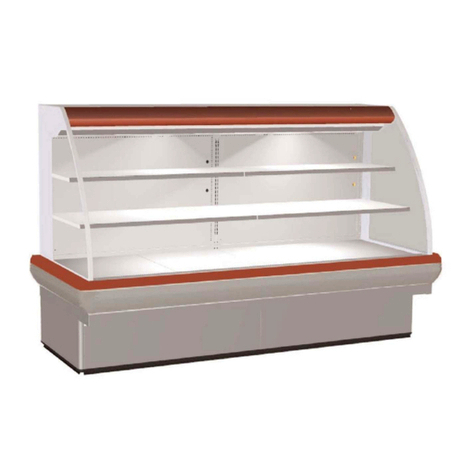
Bonnet Neve
Bonnet Neve Epta PATIO installation instructions

Winco
Winco EDM-2 Operating instructions manual
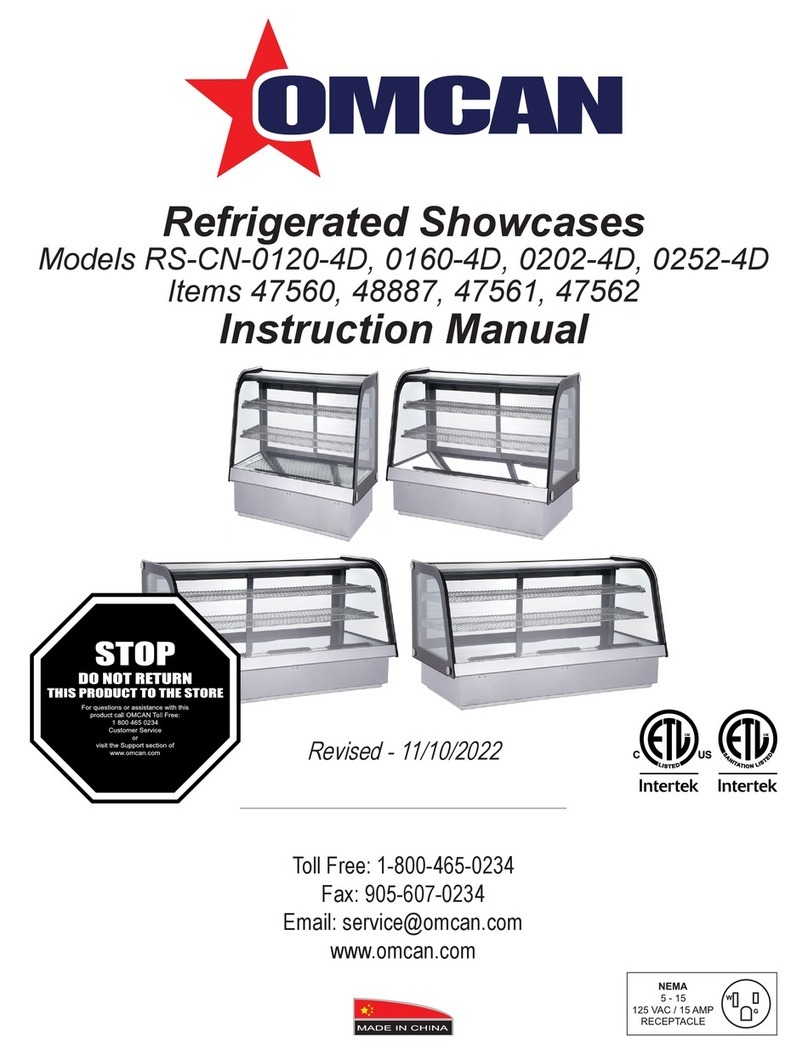
Omcan
Omcan RS-CN-0120-4D instruction manual
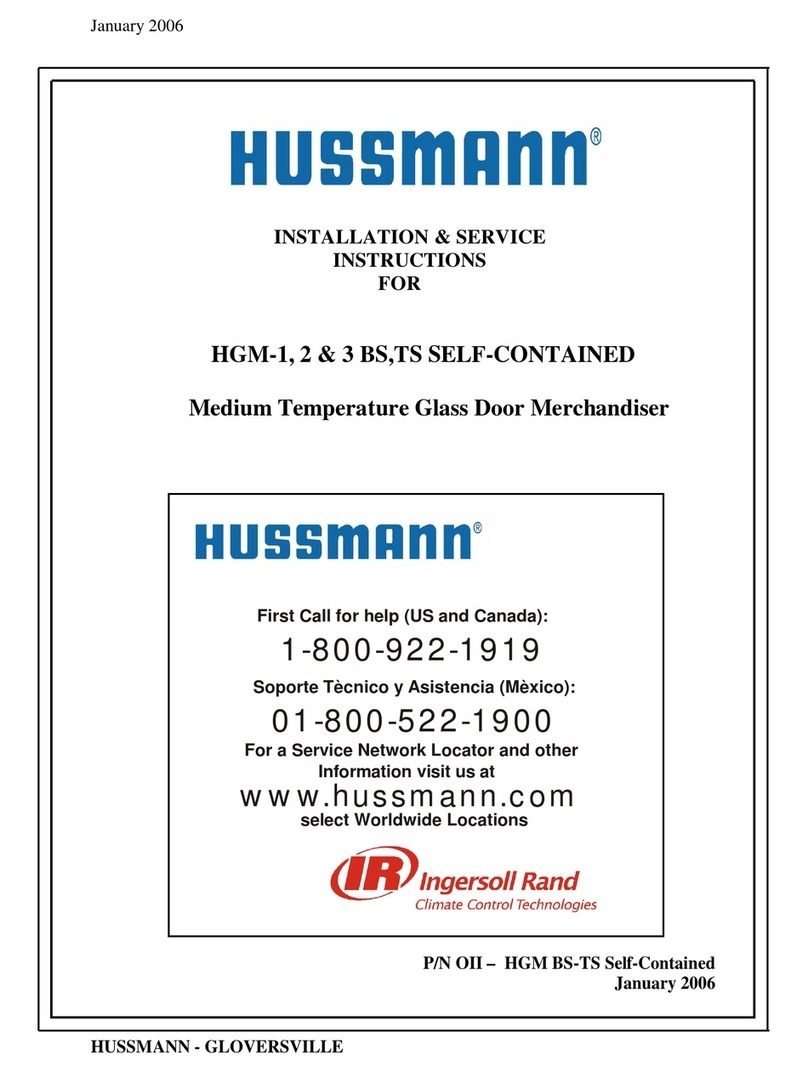
Hussmann
Hussmann HGM-1BS Installation and service instructions
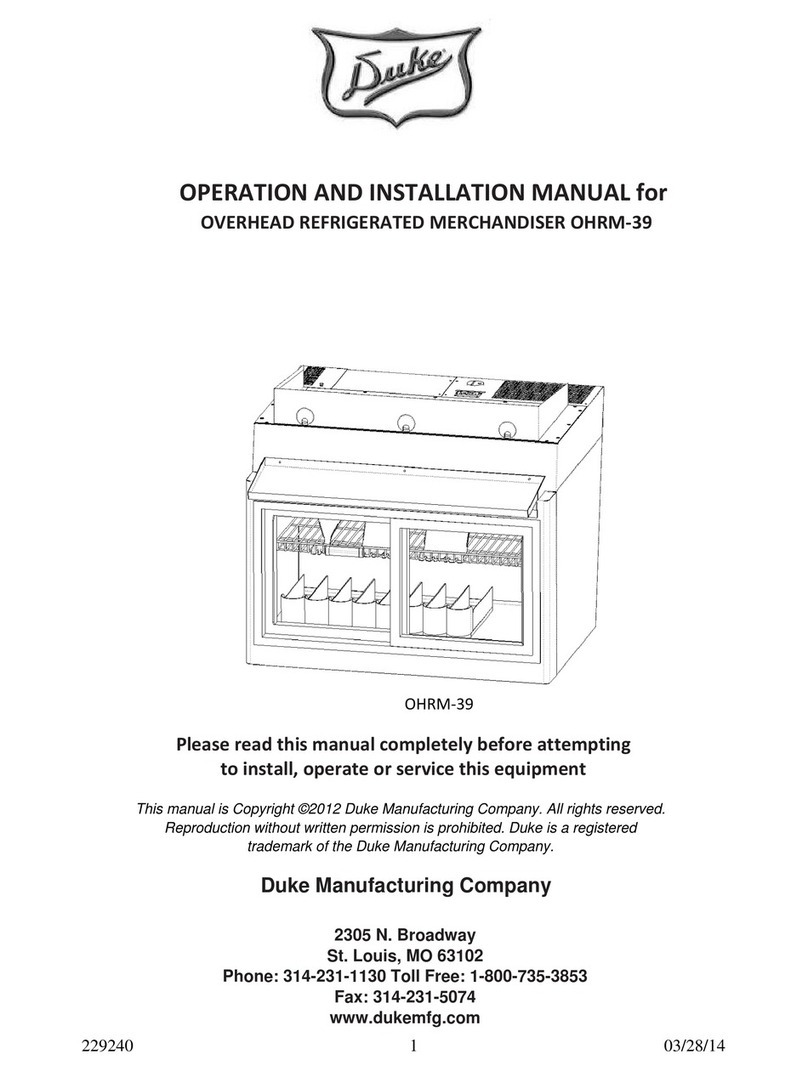
Duke
Duke OHRM-39 Operation and installation manual

Hussmann
Hussmann Impact Excel M5X-GEP Technical data sheet
